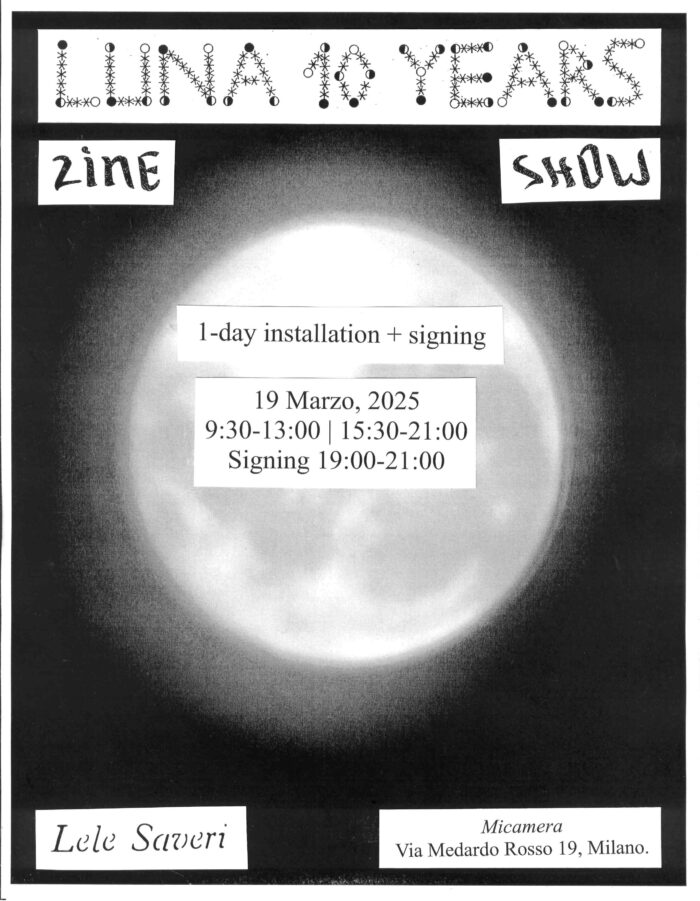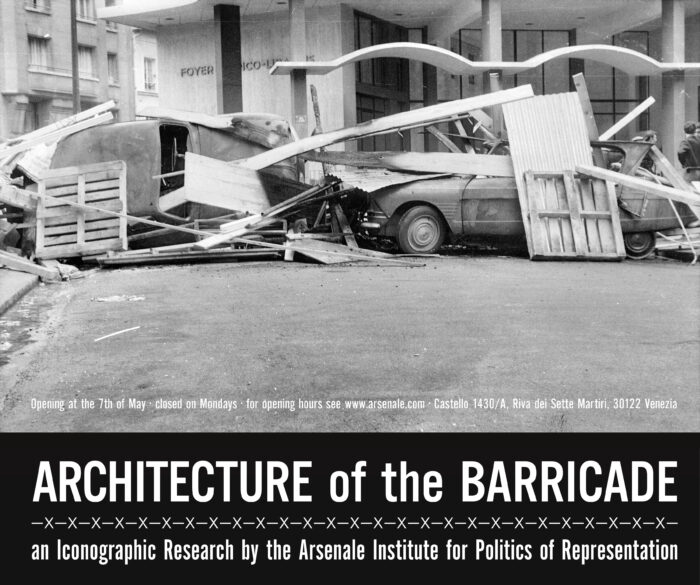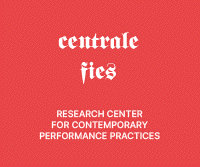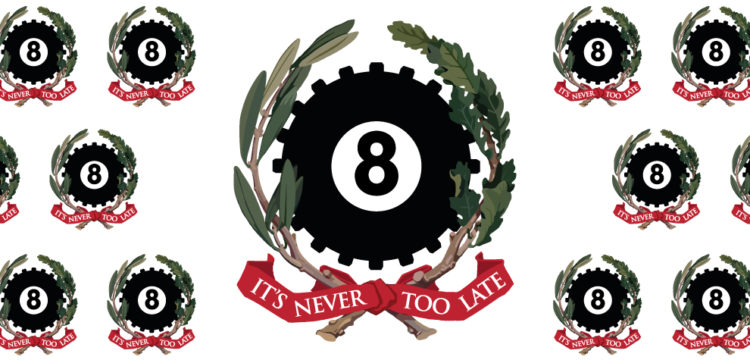Luna
A zine for each full moon
Luna is an ongoing zine project by photographer Lele Saveri, self-published on the occasion of every full moon since October 2014. For each issue, Saveri selects photographs taken during the previous lunar cycle, make 4×6 inch prints, and lays them out on blank folded sheets of paper, reproducing 20 to 30 copies with black-and-white Xerox machines. The majority of them are given away for free, with a few sold at bookstores or book fairs.
The selected images document Saveri’s experiences, encounters, and surroundings from that month, covering subjects like street scenes—primarily in New York City, where Saveri works in Emergency Medical Services—portraits of friends and strangers, street protests, and quiet, often overlooked corners of everyday life. Luna 10 Years reproduces chronologically selections of all 124 zines made through October 2024 marking the series’ tenth anniversary.
This Friday March 14th the project will be presented at Leporello, Rome, through an exhibition and a talk, and on March 19th at Micamera in Milan, with an installation and book-signing.
Why the moon? And where does the idea for this project come from?
The project started almost as a joke. The end of August/beginning of September 2014 had been a particularly strange one for me—I felt I was cursed, after having lost 2 wallets, my keys and my passport. When I spoke about it with some girlfriends, they were telling me how “strong” they had “felt” the moon influences on their lives that month. I’m generally pretty skeptical with spiritual conversations, but I didn’t want to dismiss their thoughts. So we planned a radio show (on the newly started 8ball Radio) to discuss the moon and its influence on our lives, on a full moon night. While there, I brought a few small prints and laid out a zine, kinda just for fun. That was the first issue of Luna. From then on, I am getting in synch with them moon, I use it as a metronome and it gives rhythm to my work, allowing me sometime every month to stop, and look back at the month that just passed.
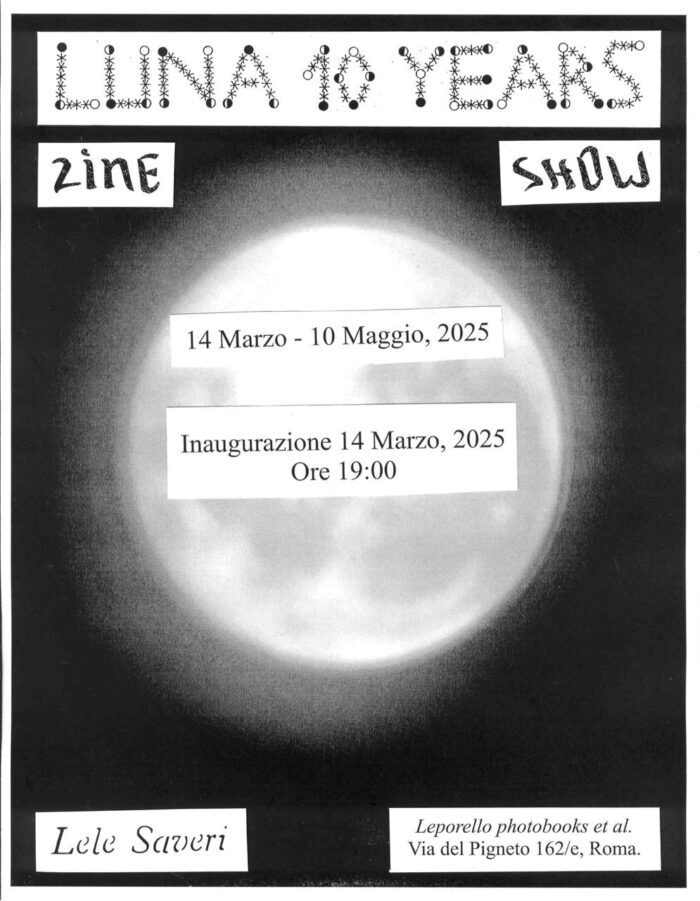
Could you please tell us about your modus operandi for this series?
It’s pretty basic. On a full moon day, wherever I happen to be in the world, I select photos taken since the previous full moon. I get them printed on photo paper, lay them out on blank sheets of paper, make a title by using parts of a stencil, and xerox 20/30 copies. I mostly end up giving them out during the following month to friends and other people I spend time with.
How do you incorporate publishing into your practice, and what role do you associate with publising?
I consider myself a documentarian. Therefor publishing is a way for me to tell a story, and the most natural way to see my work, basically. I enjoy publishing my own zines more than I do making “real” books, with a publisher and a designer. With zines I feel total control and freedom.

What is the relationship between community building and publishing?
I see independent publishing as a way of building community, naturally. It’s a small scene, where no one is really making any money, so we already have that strong bound. Then there’s the concept of sharing ideas and information, unfiltered, and that’s part of the legacy of small and independent publishing, which has historically helped creating communities and making them tighter.
How do you determine what should be distributed for free and what should be sold?
I try to keep Luna free as much as possible, and end up selling just a few, sometimes, to try cover some production cost. I like the idea of having something to give away for free, like a gift every time I reconnect with an old friend, or anytime I meet a new friend. This doesn’t mean I don’t also feel that people should understand the value of the time an artist invests into making anything, even a small pamphlet.

What value do you attribute to analog formats?
For the zines, I lay everything straight on paper, without scanning or using computers, mostly because I often encounter issues when I work with computer programs, so it becomes easier, and more pleasurable for me to make them this way (and I prefer the look of it). When it comes to photography, I used to be way more fixated on what camera I should or should not use. Then one day, while talking with Jill Friedman (a legendary street photographer and old friend of mine, who passed away a few years back), she told me “who gives a damn if this photo was taken with a Leica or a disposable camera, the important thing its that you didn’t miss it!” I still struggle sometimes with the concept of digital photography, because it feels intangible to me—and because the limitation of the 36 photos of a roll, makes me compose a better frame and shoot less useless pictures. For Luna, I use a mix of film and digital—the first few years with an old compact digital camera that used to belong to my grandad, the past 5 years taken with my phone—because it allows me to take pics while at work, in the ambulance.
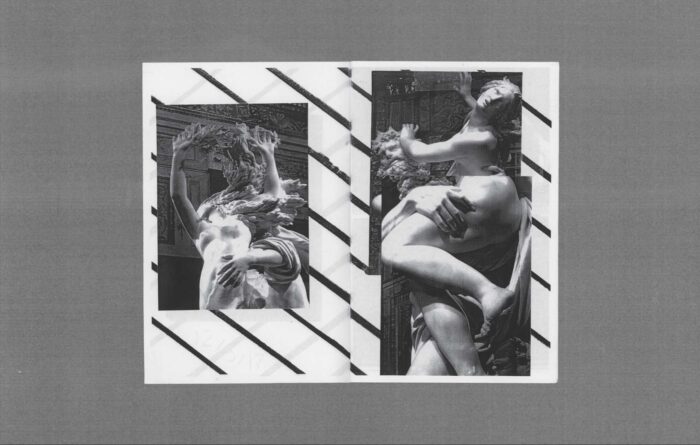
How do you distribute the zine, and what kind of circulation does it have?
Luna is mostly given by hand, so if you meet me in person, you may get one. I sometimes sell them at book fairs, or drop some off at small bookstores in NY and other countries when I travel. If you appeared on a zine, I usually try to get you a copy.
Luna is a 10-year-long project, and you have been quite active in the independent publishing scene, especially in New York with the 8-Ball community and fair. How do you see the evolution of publishing over these past 10 years?
It’s hard to tell. When I got involved with independent publishing, close to 20 years ago now, things were much different than today, obviously. Over the years we’ve seen many changes, but with the constant looming threat of “no one buys books anymore,” we’ve also seen a lot more interest in people making their own publications. I think we’re now in an era where books aren’t sold in the same way/the same quantities as they used to, but people still love the idea of discovering new, niche things, while at the same time artists/writers found easier/cheaper ways of having their own works published, skipping some of the old way of doing things, with a publisher and all.
I do think we’re in some in-between moment tho, where work gets published, but no one gets paid what they deserve. We see that same thing in the music industry. So my hope is that we find ways to have things being produced, while having artists supporting their lives with their work, so they can continue produce the art we love so much.
